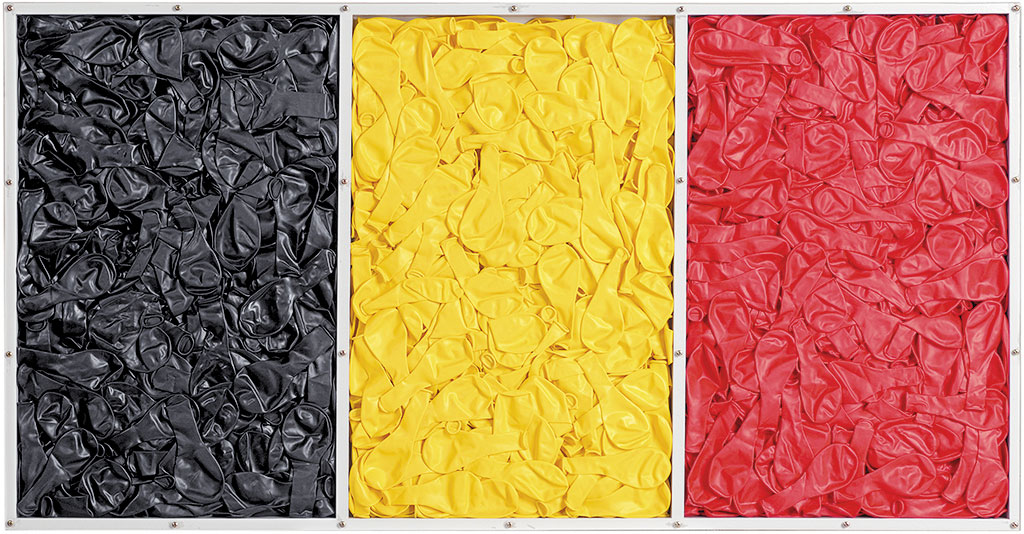Current and announcment
Jean-Pierre Bredo When I Lose Myself in Human Memory
Indefatigably, for a quarter of a century, Jean-Pierre Bredo, a Walloon artist, has been creating works in which he juxtaposes the three colours from the Belgian flag: black, yellow and red. Ready-made objects – found, bought or given to him by friends, new and old, useful and practical, such as thermoses, jugs and watering cans, plastic cutlery, handbags, parts of a wardrobe or protective clothing, gadgets and toys, and last but not least, recycled packaging, corks and bottle caps – the artist uses his entire collection to create paintings, sculptures and objects, environment and installations.
The impetus for the artist’s work with the national colours came from a television programme in which the presenter showed a floor rag, a national product, marked with three lines in the colours of the national flag. This was at a time when world opinion was shocked by the Dutroux affair – a deviant, multiple rapist and murderer (at the time, Belgium abroad evoked definitely negative associations, with a third of the country’s citizens bearing the name of the criminal having changed it to something else). Jean-Pierre Bredo decided that a floor rag, marked with the tricolour black-yellow-red, was very appropriate to ‘clean the Belgian house’. The artist framed a ready-made ‘Belgian’ floor rag; he built a proud column out of a pile of such rags, thus documenting the controversial use of state symbols and exploring the social reaction: how could this be accepted?
In developing the theme of the tricolour, the artist plays a game on many fields and levels. He is aware that the tricolour is a question of national identification and identity: the country’s identifying mark, taken from Brabant heraldry, and the symbolic interpretation of colours, with which every Belgian child is familiar – black is mourning and death; yellow is wealth and gold; red is the blood sacrifice of generations – is just as important to him as the general psychological effect of colours, about which Johann Wolfgang von Goethe wrote insightfully and accurately in his famous ‘Farbenlehre’ (‘Theory of Colours’). The findings of the great Weimar citizen are respected by film-makers, who are aware of the effectiveness of colours on the screen, and by Jean-Pierre Bredo as well: he has experimentally verified that yellow is the most accepting and friendly colour of the Belgian ribbon, while producers are least likely to use black (anyway, ‘Any colour is good as long as it doesn’t interfere with trade’).
The author does not approach the issues raised with deadly seriousness, on the contrary: he refers to the history of art with great freedom, enough to mention two examples: ‘Pointillism’ is a painting-accumulation of plastic caps poured into a flat display case; in the work ‘À chacun son trône’ (‘Throne for Everyone’) the artist embarks on a path whose stages are marked by the works of Duchamp and Oldenburg – the use of a urinal or toilet bowl. ‘A Throne for Everyone’ provoked a significant amount of questions, criticism and indignation over the juxtaposition of toilet seats in the colours of the national flag in a ‘degrading and vulgar’ place, ‘where, as we would say, one must spend a penny’. We can see clearly in this work what characterises Jean-Pierre Bredo’s entire artistic practice: a poetic distance from social, national, class or economic myth (note the titles of the works, such as ‘Opium for the People’).
By critically probing the peculiarities of a sense of communal bonds – social or national, of identification with the state or another community, the artist adopts an ironic and self-ironic stance, bordering on mockery and humour, convinced that the viewer of art is in any case capable of reading the form of the work and its content according to his or her sensitivity, experiences and cultural resources of consciousness. This distance clearly articulated by the author in his works gives them the value of a universal message, transcending the experience of a mere ‘sense of Belgitude’.
—Jan Trzupek

Curator
Wodek
The exhibition will be open from 7 May 2024.
The vernissage will begin at 6 pm on 18 May 2024.
Artist will be present.
The exhibition will run until 9 June 2024.





















